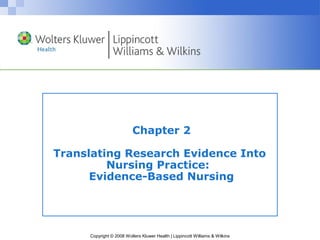
Po bech02(1)
- 1. Chapter 2 Translating Research Evidence Into Nursing Practice: Evidence-Based Nursing Copyright © 2008 Wolters Kluwer Health | Lippincott Williams & Wilkins
- 2. Research Utilization (RU) Versus Evidence-Based Practice (EBP) Research utilization (RU) The use of study findings in a practical application unrelated to the original research Evidence-based practice (EBP) Basing clinical decisions on best possible evidence—especially high- quality research Copyright © 2008 Wolters Kluwer Health | Lippincott Williams & Wilkins
- 3. Resources for Evidence-Based Practice • Systematic reviews • Clinical practice guidelines • Other preappraised evidence Copyright © 2008 Wolters Kluwer Health | Lippincott Williams & Wilkins
- 4. Research Integration and Synthesis Forms of integrative reviews: • Narrative, qualitative integration (traditional review of quantitative or qualitative results) • Meta-analysis (statistical integration of results) • Metasynthesis (theoretical integration of qualitative findings) Copyright © 2008 Wolters Kluwer Health | Lippincott Williams & Wilkins
- 5. Barriers to Using Research in Nursing Practice • Research-related barriers • Nurse-related barriers • Organizational barriers • Barriers related to the nursing profession Copyright © 2008 Wolters Kluwer Health | Lippincott Williams & Wilkins
- 6. Steps of Individual EBP 1. Framing an answerable clinical question 2. Searching for relevant research-based evidence 3. Appraising and synthesizing the evidence 4. Integrating evidence with other factors 5. Assessing effectiveness Copyright © 2008 Wolters Kluwer Health | Lippincott Williams & Wilkins
- 7. Appraisal of Evidence • Validity of study findings • Clinical importance of findings • Precision of estimates of effects • Associated costs and risks • Utility in a particular clinical situation Copyright © 2008 Wolters Kluwer Health | Lippincott Williams & Wilkins
- 8. EBP in Organizational Context • More formalized than individual EBP • Must take organizational and interpersonal factors into account • “Triggers” include both pressing clinical problems and existing knowledge Copyright © 2008 Wolters Kluwer Health | Lippincott Williams & Wilkins
- 9. Organizational (Team-Based) EBP Projects • Involve the development or adaptation of clinical practice guidelines or clinical protocols • Assessment of implementation potential of the innovation Transferability Feasibility Cost/benefit ratio Copyright © 2008 Wolters Kluwer Health | Lippincott Williams & Wilkins
- 10. Criteria for Evaluating the Implementation Potential of an Innovation Under Scrutiny Copyright © 2008 Wolters Kluwer Health | Lippincott Williams & Wilkins
- 11. Implementing and Evaluating the Innovation Pilot Test • Develop an evaluation plan • Collect information on outcomes • Train staff in the use of the new guideline and, if necessary, “market” the innovation • Try the guideline out on one or more units or with a group of clients • Evaluate the pilot project Copyright © 2008 Wolters Kluwer Health | Lippincott Williams & Wilkins
- 12. Nurses’ Role in Using Research Evidence • Read widely and critically • Attend professional conferences • Learn to expect evidence that a procedure is effective • Become involved in a journal club • Pursue and participate in RU/EBP projects Copyright © 2008 Wolters Kluwer Health | Lippincott Williams & Wilkins